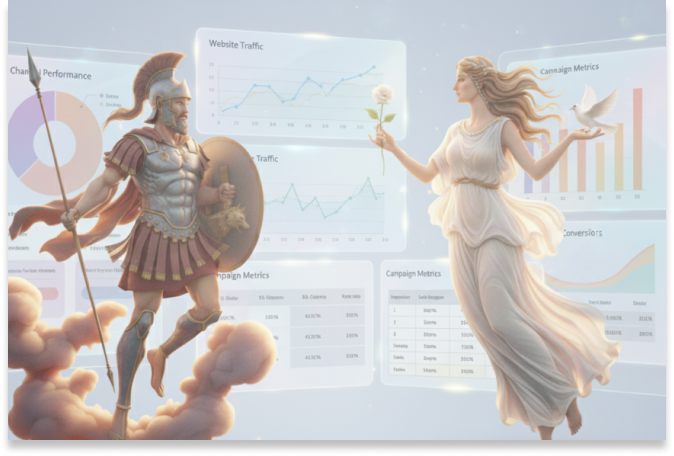
Data analysis is an extremely powerful tool for anyone looking to improve their marketing.

The popular relationship book "Men are from Mars, Women are from Venus" (1992) by John Gray, uses a metaphor to explain that many relationship problems are due to fundamental psychological differences.
Paraphrasing this idea, we will draw a parallel in today's marketing between two vital entities that generate conflicting feelings of love and hate: the Campaigns and the Customers.
Just as men and women metaphorically come from different planets (Mars and Venus), with different ways of thinking, communicating and reacting; campaigns and clients also come from different planets. Therefore, they require different ways to Measure, Optimize and Customize.
In this first part of our article, we will focus on the substantial difference between metrics and KPIs in these two worlds, and how they should be strategically connected for marketing efforts to impact the bottom line.
The campaigns are Mars (the red planet), named after the Roman god of war. Its very name evokes conquest and victory. Campaigns are usually fast, powerful and voluminous. Their goal is to win customers, generate conversions, period. They are the adrenaline and dopamine of marketing.
Their objectives are generally tactical and its metrics and KPIs live in the short termin the present: Opening rate (open rate), Click-through rate (click-through rate), Conversion rate (conversion rate), Return on advertising investment (ROAS), Acquisition cost, Average purchase ticket.
For measuring campaigns, we could even dispense with the concept of the customer; the audience would be sufficient. The campaign is a SPEED RACINGa sprint.
On the other hand, customers are from Venus (the white planet), named after the Roman goddess of love. It tells of a deep and lasting relationshipThe marketing endorphins, based on trust, that cultivate value and loyalty. They are the serotonin and endorphins of marketing.
Your objectives should always be to strategic and its metrics and KPIs live in the medium/long termin the future: Long-term customer value (customer lifetime value - CLV), Satisfaction index, Risk of leakage.
I recommend this article of the teacher Peter Fader of the Wharton School (a benchmark in the strategic calculation of CLV).
The customer is a long-distance racea marathon.
Since they come from different planets, campaigns and clients have different metrics and KPIs: different dimensions, proportions and units of measurement.
As we said at the beginning, they are predestined to coexist, just as the tree is predestined to coexist with the forest. However, the trees of the campaigns sometimes prevent us from seeing the forest of the clients.
The main challenge lies in the fact that we could be successful in campaign metrics and, at the same time, fail in customer metrics. Indiscriminate solicitation campaigns can attract new customers who may not be profitable in the long run. Indiscriminate discount campaigns can undermine the profitability of the most valuable customers.
Achieving the best campaign metrics does not necessarily imply better customer metrics.. This is the real challenge, because we need to succeed in both campaigns and customers.
We could go a month without campaigns, but we couldn't go a month without customers. Campaigns happen, but customers remain.
We need both, and the key is combining them in a balanced wayHow do we know if we are doing it correctly? Here are a series of questions that can help us to weigh that balance:
If the answer to these questions is in the majority, then the following is true refusalwe are faced with the possibility that our marketing campaign management is disconnected from our customer strategyThis could be wasting marketing efforts that do not end up contributing to the bottom line of the business.
If, on the other hand, we already have a Dashboard of metrics of both gods of Olympus (Mars and Venus)Since we have completely different metrics in essence, the next question is:
¿Which ones should we maximize?
We leave the answer to this question for the second part of this article. Enjoy.

Data analysis is an extremely powerful tool for anyone looking to improve their marketing.

How to calculate the Customer Lifetime...
According to a Columbia University study, the average cost of acquiring a new customer is six times higher than...

A data-driven company is one that bases its decisions and strategies on data and analytics. This means that...